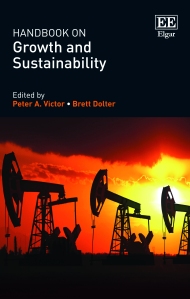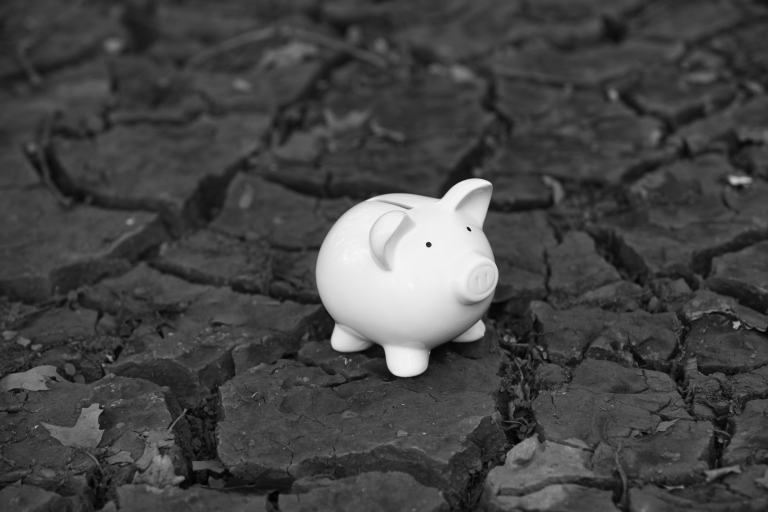Brett Dolter and Peter Victor discuss growing the global economy and combatting climate change.
Climate change is a “super wicked problem” (Levin et al., 2012). Stopping the rise of global temperatures requires complete decarbonization of our energy system. This shift will upend existing power structures, and disrupt habits and behavioural norms. To add to the challenge, climate change action requires co-operation amongst countries with competing interests, and demands social support for actions that impose costs on citizens today, but will provide benefits primarily to generations not yet born.
In Paris, we saw an emerging commitment to global co-operation as nations around the world pledged to reduce their greenhouse gas (GHG) emissions (UNFCCC, 2015). Nearly two years later, however, researchers have confirmed that “No major advanced industrialized country is on track to meet its (Paris) pledges to control the greenhouse-gas emissions that cause climate change” (Victor et al. 2017).
One characteristic of the “super wicked problem” that is climate change is that “those seeking to end the problem are also causing it” (Levin et al., 2012: 127). We know that every economic transaction requires materials and energy. In a world where our energy system is powered predominantly by fossil fuels, that means every economic transaction creates GHG emissions directly, or indirectly in its supply chain (Dolter & Victor, 2016). Even purchases from the service sector – for example, visiting a masseuse or a barber – generate embodied or shadow GHG emissions (Dolter & Victor, 2016).
In this context, several researchers in the new Handbook on Growth and Sustainability(Victor & Dolter, 2017) have asked, can we address climate change while growing our economy?
The tension between economic growth and reducing GHG emissions can be expressed using the Kaya Identity, which decomposes changes to GHG emissions in terms of its component parts: changes to population, changes to economic activity per capita (GDP/capita), changes to the energy intensity of economic activity (Energy/GDP), and changes to the GHG intensity of energy (GHG/Energy),
Kaya Identity
Globally, GDP/capita and population have been increasing, while the energy intensity of the economy (Energy/GDP) and the GHG intensity of energy (GHG/energy) have been declining. A complete decarbonization of global energy systems would zero out the first term on the right-hand-side of the Kaya Identity (GHG/Energy = 0), reducing GHG emissions to zero, and helping to stabilize concentrations of GHGs in the atmosphere.[1] But, decarbonization of our energy system will not happen overnight. In the meantime, if global GHG emissions are to be reduced, GHG/Energy and Energy/GDP must decline faster than GDP/capita and population grow.
In western liberal democracies, we generally do not look to population control as a solution to climate change, and, in any case, the rate of population growth in rich nations has been declining for decades.[2] This means the race is between GDP growth (GDP/capita), and efforts to decarbonize the energy system (GHG/Energy) and achieve more energy efficiency economic production (Energy/GDP).
Paul Ekins (2017) argues that we can help steer our economy towards low-carbon technologies by implementing a steadily increasing carbon price. In his Handbook chapter, he points to economic modelling studies that show that GDP can continue to grow, while GHG emissions fall and atmospheric GHG concentrations stabilize. Achieving GHG emissions reductions will mean shifting economic activity away from consumption and towards investment. It may be politically difficult to convince voters to support deferred consumption, but, “because economic growth is so attractive to so many people” Ekins argues that promising green growth will make climate action more appetizing to the electorate (Ekins, 2017: P.134).
Anders Hayden (2017) is less convinced of the potential to square the growth and sustainability circle. Hayden (2017) outlines several issues with the kinds of economic modelling studies cited by Ekins (2017): they assume perfect market conditions, ignore technological lock-in, ignore rebound effects from achieving energy efficiency, and often rely on untested carbon dioxide removal (CDR) technologies that allow us to overshoot our GHG emissions targets, only to reach them later by removing CO2 from the atmosphere. Rather than continuing to promote economic growth (even if green), Hayden argues we should be promoting an “ethic of sufficiency” so that “the ecological imperative of addressing climate change and other environmental challenges is no longer held back by the perceived imperative of endless economic growth” (2017: pp. 139, 154)
The Handbook on Growth and Sustainability provides additional perspectives on whether we can stop the advance of climate change while growing the global economy. Daly (2017) argues for a steady-state, non-growing economy. Sekulova et al. (2017) suggest that rich nations should now focus on degrowth. van den Bergh (2017) proposes an agrowth view that we should be agnostic about economic growth, and instead measure social progress with a broader swath of indicators. The Handbookthen goes beyond this debate to explore what our economy and society could look like if we opted to dethrone economic growth from its place as the primary goal of social policy.
The release of the Handbook is timely. Raftery et al. (2017) recently concluded that we have only a 5% chance of limiting global warming to 2°C by 2100. Using the Kaya Identity framework and statistical analysis of past and likely future trends, they conclude that the carbon intensity of economic activity (will likely decline by 1.9%/yr, but these improvements will largely be cancelled out by likely economic growth of 1.8%/yr (Raftery et al., 2017: 3).
This finding suggests that, in the most likely scenarios, we will not halt climate change while growing the economy. While challenging the primacy of economic growth may create new wicked problems, failing to solve the super wicked problem that is climate change will be catastrophic. It is our hope that the 23 chapters in the Handbook on Growth and Sustainability help to clarify whether we can stop the advance of climate change while growing the global economy, and, if not, how we might achieve well-being without growth.
[1] To completely stabilize atmospheric concentrations of GHGs, emissions in non-energy sectors like agriculture must also be reduced to zero or near-zero (allowing for some carbon sequestration in forests and oceans).
[2] Population growth is also not believed to be a major impediment to reducing GHG emissions globally (Raftery et al., 2017). This assumes, however, that areas with high population growth such as Sub-Saharan Africa, continue to stay poor. It also assumes that those living in poverty don’t exacerbate climate change by, for example, harvesting fuelwood from forests and contributing to deforestation. One reason for questioning economic growth in rich nations is to free up ecological space and resources to allow for poverty alleviation in poor nations.
References
Daly, Herman (2017) “A New Economics for Our Full World.” In (Eds.) Victor, Peter and Brett Dolter The Handbook on Growth and Sustainability. Edward Elgar: Cheltenham, MA.
Dolter, Brett and Peter A. Victor (2016) “Casting a long shadow: Demand-based accounting of Canada’s greenhouse gas emissions responsibility.” Ecological Economics. 127, pp. 156-164. DOI: 10.1016/j.ecolecon.2016.04.013.
Ekins, Paul (2017) “Ecological Modernisation and Green Growth: Prospects and Potential.” In (Eds.) Victor, Peter and Brett Dolter The Handbook on Growth and Sustainability. Edward Elgar: Cheltenham, MA.
Hayden, Anders (2017) “Climate Change, Growth, and Sustainability.” In (Eds.) Victor, Peter and Brett Dolter The Handbook on Growth and Sustainability. Edward Elgar: Cheltenham, MA.
Levin, Kelly, Benjamin Cashore, Steven Bernstein, and Graeme Auld (2012) “Overcoming the tragedy of super wicked problems: constraining our future selves to ameliorate global climate change.” Policy Sciences. 45, pp. 123-152. DOI: 10.1007/s11077-012-9151-0.
UNFCCC (2015) Paris Agreement. Available on-line at: http://unfccc.int/files/essential_background/convention/application/pdf/english_paris_agreement.pdf. Last accessed August 4, 2017.
Raftery, Adrian E., Alec Zimmer, Dargan M.W. Frierson, Richard Startz, and Peiran Liu (2017) “Less than 2°C warming by 2100 unlikely.” Nature Climate Change. DOI: 10.1038/NCLIMATE3352.
van den Bergh, Jeroen C.J.M. (2017) “Green Agrowth: Removing the GDP-Growth Constraint on Human Progress.” In (Eds.) Victor, Peter and Brett Dolter The Handbook on Growth and Sustainability. Edward Elgar: Cheltenham, MA.
Victor, David G., Keigo Akimoto, Yoichi Kaya, Mitsutsune Yamaguchi, Danny Cullenward & Cameron Hepburn (2017) “Prove Paris was more than paper promises.” Nature, August 1, 2017. Available on-line at: http://www.nature.com/news/prove-paris-was-more-than-paper-promises-1.22378.
Victor, Peter and Brett Dolter (Eds.) (2017) The Handbook on Growth and Sustainability. Edward Elgar: Cheltenham, MA.
Peter A. Victor, Professor, York University and Brett Dolter, Post-doctoral Research Fellow, University of Ottawa, Canada

Handbook on Growth and Sustainability is available now.
Read chapter one for free on Elgaronline.

